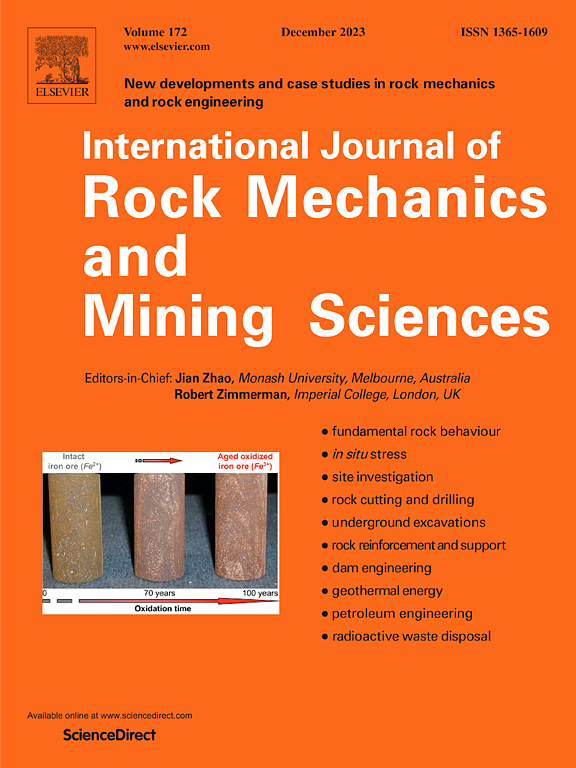A regularized fracture-based continuum model for simulating tunneling-induced rock mass collapse
IF 7.5
1区 工程技术
Q1 ENGINEERING, GEOLOGICAL
International Journal of Rock Mechanics and Mining Sciences
Pub Date : 2025-03-24
DOI:10.1016/j.ijrmms.2025.106086
引用次数: 0
Abstract
Tunneling in brittle rock masses under high stress may be accompanied by fracture-induced collapses, that is a complete loss of the structural load carrying capacity. Predicting the location and extent of the collapses is crucial for ensuring construction safety and designing support systems. This study proposes a novel fracture-mechanics-based continuum model for simulating excavation-induced collapses in highly stressed rock masses. It captures the excavation damaged zone caused by microcrack initiation as well as the transition to a highly damaged zone formed by macroscopic fracture propagation. The modeling is unique in that the simulated cracks are regularized to alleviate the mesh dependency. For large-scale problems the mesh size selection depends only on the characteristic length of the smeared fracture band. It is shown that the correct scaling of in tunnel-scale problems enables relatively coarse meshes to be adopted, significantly reducing computational time. Additionally, a novel method for introducing structural discontinuities into an excavated rock mass is presented, enabling the simulation of interactions between pre-existing geological discontinuities and excavation-induced fractures. Two tunnel excavation case studies are presented, demonstrating the model's capability of simulating fracture propagation, final collapse zones and corresponding rock mass deformation induced by excavation.
一种正则化裂隙连续体模型用于模拟隧道围岩坍塌
在高应力作用下的脆性岩体中,隧道开挖可能伴随着断裂破坏,即结构承载能力的完全丧失。预测塌方的位置和范围对保证施工安全和设计支护系统至关重要。本文提出了一种新的基于断裂力学的连续体模型,用于模拟高应力岩体中开挖引起的崩塌。它捕捉了由微裂纹萌生引起的开挖损伤区以及由宏观断裂扩展形成的向高度损伤区过渡。该模型的独特之处在于对模拟的裂缝进行了正则化,以减轻网格依赖性。对于大规模问题,网格尺寸的选择仅取决于涂抹断裂带的特征长度10。结果表明,在隧道尺度问题中,正确的尺度为10可以采用相对粗糙的网格,大大减少了计算时间。此外,提出了一种将结构不连续面引入开挖岩体的新方法,从而可以模拟先前存在的地质不连续面与开挖引起的裂缝之间的相互作用。给出了两个隧道开挖实例,验证了该模型能够模拟开挖引起的裂隙扩展、最终坍塌区域和相应的岩体变形。
本文章由计算机程序翻译,如有差异,请以英文原文为准。
求助全文
约1分钟内获得全文
求助全文
来源期刊
CiteScore
14.00
自引率
5.60%
发文量
196
审稿时长
18 weeks
期刊介绍:
The International Journal of Rock Mechanics and Mining Sciences focuses on original research, new developments, site measurements, and case studies within the fields of rock mechanics and rock engineering. Serving as an international platform, it showcases high-quality papers addressing rock mechanics and the application of its principles and techniques in mining and civil engineering projects situated on or within rock masses. These projects encompass a wide range, including slopes, open-pit mines, quarries, shafts, tunnels, caverns, underground mines, metro systems, dams, hydro-electric stations, geothermal energy, petroleum engineering, and radioactive waste disposal. The journal welcomes submissions on various topics, with particular interest in theoretical advancements, analytical and numerical methods, rock testing, site investigation, and case studies.

 求助内容:
求助内容: 应助结果提醒方式:
应助结果提醒方式:


